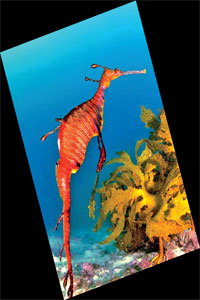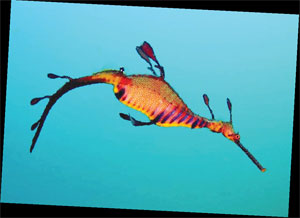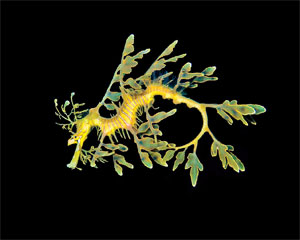Dragons in the
sea?
Who isn’t afraid of dragons, especially those that breathe fire and come
chasing us , not in reality of course but in story books and dreams?
Most of us grow up reading stories where dragons generally make an
appearance and the majority of them are dreadful creatures... It is
rarely that we come across dragons that are friendly and harmless even
in the fantasy world like Puff the magic dragon. .So, naturally the very
mention of dragons used to send a chill down our spines when we were
young enough to think they did really exist.
|

A male Weedy sea dragon with eggs on the brood patch |
Today we like to introduce you to two beautiful dragons that really
do exist, not on land but in the sea. You may never have the wonderful
opportunity of seeing them unless of course you grow up to be a great
diver and go deep sea diving someday.
Have you ever heard of a variety of marine species known as sea
dragons that resemble sea horses? Well, if you have not then it is time
you did because they are one of the most spectacular and mysterious of
all ocean creatures .Sea dragons are pipe fish and are related to sea
horses. But unlike the sea horses they have appendages on their bodies.
They have parts that look like sea weeds and leaves on their head and
body that allow them to hide in sea grass and sea weed. They have a
variety of colours including yellow, pink and orange.
The juveniles are pinker in colour. The sea dragons have
extraordinary vision because they can
look in two directions at once, However, it can be very difficult to
notice the subtle movements of their eyes. Their rigid skin further
hinders their movements. Instead of scales, Sea dragons have protective
armor that keeps them from predators. The row of spines along their
backs can also wound attackers; sometimes Sea dragons curl into balls
like porcupines in self defence.
There are two types of sea dragons: the leafy sea dragon and the
weedy sea dragon, sometimes known as the common sea dragon, or by its
scientific name, phyllopteryx taeniolatus. The weedy sea dragon is the
larger of the two and is not to be confused with the sea horse, a
distinctly separate species.
The leafy sea dragon or Glauert’s seadragon Phycodurus eques, belongs
to the family Syngnathidae, and is the only member of the genus
Phycodurus.
It is found along the southern and western coasts of Australia, South
Australia and further east along the coastline of Victoria province,
Australia.

This tiny creature has been so named because of the long leaf-like
protrusions coming from all over its body which are not used for
propulsion but serve only as camouflage. When it comes to propulsion it
uses a pectoral fin on the ridge of its neck and a dorsal fin on its
back closer to the tail end to do so. These small fins are almost
completely transparent and difficult to see as they undulate minutely to
move the creature sedately through the water, completing the illusion of
floating seaweed.- It moves in a graceful glide as though an invisible
hand is helping it to do so in slow-motion.
This movement appears to mimic the swaying movements of the seaweed
and kelp. Only close observation reveals movement of an eye or tiny
fins.It can also change colour to blend in, but this ability depends on
the sea dragon’s diet, age, location, and stress level.Individual leafy
sea dragons have been observed remaining in one location for extended
periods of time (up to 68 hours) but will sometimes move for lengthy
periods.
The leafy sea dragon is very much like the seahorse but slightly
larger than most seahorses, growing to about 20- 24 cm (8-10 in). It
primarily eats crustaceans including plankton and mysids, but its diet
also includes shrimp and small fish.It catches prey with the aid of its
camouflage and feeds using its long, pipe-like snout. Leafy sea dragons
oddly enough do not have teeth, which is rare amongst animals that eat
small fish and shrimp.
A related species is the weedy sea dragon, which is multi-coloured
and grows weed-like fins but is smaller than the leafy sea dragon.
|

Weedy sea dragon |
Most of you will be surprised to learn that like their cousin the
seahorse, the male leafy sea dragon is the one who takes care of the
eggs: it carries and incubates the eggs until they are hatched.
The female produces about 250 light pink eggs, then deposits them on
to the male’s brood patch located on the underside of the tail, via a
long tube.
The eggs then attach themselves to the brood patch, which supplies
them with oxygen.
It takes a total of nine weeks for the eggs to begin to hatch,
depending on water conditions. The brood patch is made up of tiny egg
cupped shaped suction cups that hold the eggs.The eggs turn a ripe
purple or orange over this period, after which the male pumps its tail
until the infants emerge, a process which takes place over 24-48 hours.
The male assists the hatching process by shaking his tail, and
rubbing it against seaweed and rocks. The infant sea dragons are
completely independent from birth.They eat small zooplankton until they
grow large enough to hunt mysids.
However,only about five per cent of the eggs survive to maturity
which is about 28 months.
Like the sea horses the leafy sea dragons too are highly threatened
not only due to natural reasons but also man- made. Sea dragons are
often washed ashore after storms because like the seahorses , they
cannot curl their tails and hold onto sea grass to stay safe.
Many others are caught by those who collect them for their unique
appearance and also by those who use them as alternative medicine. As
leafy sea dragons are slow swimmers especially the new born, they are
easily caught by predators.
|

Leafy sea dragon |
Weedy sea dragons inhabit a very small part of the planet; the
coastal waters off southern Australia and parts of its eastern and
western waters.
Within this area, weedy sea dragons prefer sea weed, kelp and sea
grass, all of which provide protection and allow them to blend into the
scenery. The two eyes of the weedy sea dragon too move independently of
each other. They lack two common traits of many animals: teeth and a
stomach. They have appendages that hang from their bodies resembling
weeds, hence their name. Weedy sea dragons have a long, thin, tubular
snout and distinctive blue colouration on the upper body. They can grow
up to 18 inches long. Newborns measure less than 0.4 inches and weigh
less than an ounce.Weedy sea dragons grow to a mature length of about 18
inches (45 cm). Though relatively common compared to Leafy sea dragons,
Weedy sea dragons are also government protected, and subject to strict
export controls.
Even though they are more slender and have fewer and less ornate
appendages, they have even more magnificent pigmentation. While some
Weedy sea dragons are green, yellow and brown like their cousins, many
of them are orange or purple or even have beautiful speckled patterns.
The beautiful colours of this sea dragon are highlighted by the
iridescent blue bands along the upper body.
Facts and pix: Internet
*********
Fact file...
* Sea dragons are protected under Australian law, and their export is
strictly regulated.
* The sea dragon’s body is hard, almost like armour. This hard outer
surface, called a ‘hide’ is made of bony rings. The hide makes the sea
dragons body very rigid that it can’t move quickly and is easily caught.
* Popularly known as “leafies” Leafy sea dragons are the marine
emblem of the state of South Australia .
* The lobes of skin that grow on the leafy sea dragon provide
camouflage, giving it the appearance of seaweed.
*The leafy sea dragon is related to the pipefish and belongs to the
family Syngnathidae, along with the seahorse.
* The leafy sea dragon differs from the seahorse in appearance, form
of locomotion and its inability to coil or grasp things with its tail.
* The leafy sea dragon uses the fins along the side of its head to
allow it to steer and turn. However, its outer skin is fairly rigid,
limiting mobility.
* A fully grown Leafy sea dragon grows to about 18 inches (45 cm).
* The leafy sea dragon is found only in the waters of Australia from
Kangaroo Island on the Southern shoreline to Jurien Bay. They are mostly
found around clumps of sand in waters up to 50 metres (164 feet) deep,
hiding among rocks and sea grass.
*Though they are similar in appearance to sea horses, Weedy sea
dragons do not have prehensile (gripping) tails, but rather appear to
use them for steering.
* To date, only the Tennessee Aquarium in Chattanooga, Tennessee has
been able to breed the leafy sea dragon. It is said to have first
succeeded in doing so in 2003.(Other aquaria which feature leafy sea
dragons include the New England Aquarium; the Monterey Bay Aquarium; and
the Aquarium of Western Australia).
* In 2006 an animated short film, The amazing adventures of Gavin, a
Leafy Seadragon, was made on behalf of several South Australian
organisations involved in conserving the marine environment. The film is
an introductory guide to marine conservation and the marine bio regions
of South Australia suitable for 8-12 year olds.
* Leafy sea dragons are less colourful than their Weedy sea dragon
cousins. Leafy sea dragons are usually pale green, yellow or brown in
colour. Some can change colour as part of their camouflage. Different
factors including diet, age, location and the physical and mental state
of the specimen can influence this gift.
* Weedy sea dragons on average are longer than Leafy sea dragons. |

